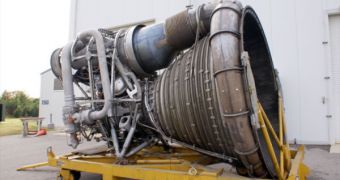The Apollo 8 mission, the historical moment when humans managed to escape the gravitational field of the Earth, orbit the Moon, and then return safely, represented a monumental achievement in many ways. Though it was only the second manned mission of the Apollo program, it managed to pave the way for the landing on the Moon, alongside breaking three difficult barriers and proving the worth of the American space program.
Now, 40 years later, a space enthusiast has managed to track down one of its engines, which has been lost to the mist of time. While on a tour conducted by Nasa, Mike Jetzer from Germantown, Wisconsin, noticed the F-1 engine and photographed it.
On his website, he wrote that "As we drove up to a tour stop used to house a plywood and PVC pipe full-scale mock-up of the Ares I frustum, interstage, and aft end of the second stage... I noticed a fairly nice-looking F-1 and nozzle extension. This is apparently Building 4205. The F-1 is approximately equidistant from the building and the nozzle extension, so I was unable to get any full side shots of the engine."
Once NASA people got a hold of the photos, they were able to finally link the thruster to Apollo 8, and the piece claimed its rightful place in a museum. The engine, produced by Rocketdyne of Los Angeles, was assembled at the Michoud Assembly Facility in Louisiana, and then shipped to NASA's Marshall Space Flight Center in Alabama, for a test firing. Afterwards, it was transported via barge to the Kennedy Space Center, where it arrived on December 27th, 1967.
After the engine was installed on Saturn V's first stage, NASA engineers noticed a malfunction on one of the fuel pumps, and sent it back to the manufacturer, for servicing, just 7 months before the planned launch. Although Rocketdyne did its best, it only completed the repairs three months before the launch, and therefore, when the engine reached the Space Center again, it was not included in the final setup.
The rejected F-1 piece, with the serial number F-4023, was then moved to Michoud, where it remained for the next 20 years, as experts wanted to analyze the effects that long-time storage had on rocket boosters. In 1990, after an inspection, Rocketdyne again moved the engine to Alabama, and then to the US Space and Rocket Center. During these displacements, the connection that F-4023 had with the historic space mission was lost.

 14 DAY TRIAL //
14 DAY TRIAL //